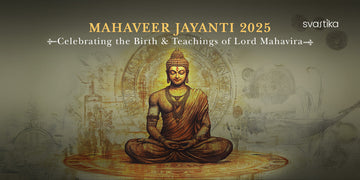Imagine a day filled with peace, devotion, and a deep sense of purpose; this is what Mahaveer Jayanti brings to millions of followers worldwide. Celebrated as Mahavir Janma Kalyanak, this sacred Jain festival marks the birth of Lord Mahavira, the 24th Tirthankara of Jainism. His teachings of Ahimsa (non-violence), truth, and self-discipline continue to inspire people across generations.
So, when is Mahavir Jayanti in 2025? This revered occasion falls on Thursday, April 10, 2025, celebrating the 2623rd birth anniversary of Bhagwan Mahavir. Devotees observe this day with prayers, temple rituals, charitable acts, and fasting, embracing the core principles of Jain dharma.
Whether through Rath Yatras, Abhisheka rituals, or acts of compassion, Mahaveer Jayanti is a reminder of the timeless values Lord Mahavira imparted to the world.
When is Mahavir Jayanti in 2025
Mahavir Janma Kalyanak: 2623rd Birth Anniversary of Mahavir Swami
-
Mahavir Jayanti Date: Thursday, April 10, 2025
-
Trayodashi Tithi Begins: 10:55 PM on April 9, 2025
-
Trayodashi Tithi Ends: 01:00 AM on April 11, 2025
Birth of Mahavira: A Divine Arrival
Mahavir Birth Place & History :-
Birthplace Of Mahavira
The 24th Jain Tirthankara Lord Mahavira was born in Kundagrama (Kundalpur), near Vaishali in modern-day Bihar India. He was born approximately 599 BCE (according to the Digambara sect) or 615 BCE (according to the Śvetāmbara sect) into a noble Kshatriya family of the Ikshvaku dynasty. King Siddhartha his father was the ruler of the Naya clan and Queen Trishala, his mother, was a pious woman who is said to have had lucky dreams that predicted the birth of a great soul.
History Of Mahavira
Vardhamana, which means one who grows or is prosperous, was given to Mahavira who was raised in royal luxury and represents the prosperity that grew in his kingdom after his birth. He was extensively trained in governance, martial arts, and philosophy. Despite coming from a princely family he showed compassion, wisdom, and a disinterest in worldly pleasures at a young age.
In accordance with Jain customs Mahavira gave up his material life at the age of thirty to pursue spiritual enlightenment leaving behind his wealthy family and royal position. He practiced severe penance and meditation for 12 years before achieving Kevala Jnana (omniscience). He established the fundamental tenets of Jainism Ahimsa (non-violence) Satya (truth) Asteya (non-stealing) Brahmacharya (celibacy) and Aparigraha (non-possessiveness) as a result of this profound realization.
Svastika Mahaveer Jain Pocket Temple - Gold & Silver Plated
Mahavir Jayanti Celebration:
Mahavir Jayanti is observed with deep devotion and reverence by Jain communities worldwide. On this sacred occasion, devotees pay homage to Lord Mahavira through various spiritual and charitable activities.
-
Processions & Prayers
Grand Rath Yatras or processions are planned in which worshippers chant prayers and hymns while idols of Lord Mahavira are set atop chariots, horses, or elephants. This fosters a spirit of reverence and devotion.
-
Temple Visits
To offer prayers, carry out rituals and participate in unique ceremonies Jains travel to temples. Abhisheka in which the idol of Lord Mahavira is bathed in milk honey and water to represent devotion and purity is a significant ritual on this day.
-
Charity & Ahimsa (Non-Violence)
Devotees uphold the non-violent principle of Ahimsa by performing deeds of kindness, giving food, and fostering compassion and peace via volunteer work and charitable endeavors while making sure that no living thing is harmed.
-
Religious Discourses
Temples and community centers host sermons and discussions on the teachings of Lord Mahavira encouraging followers to consider his teachings on self-discipline, truth and non-violence.
-
Fasting & Meditation
While some people spend the day in prayer and meditation in search of inner peace and enlightenment, many others observe fasts as a means of self-discipline and spiritual cleansing.
-
Satvik Diet & Food Practices
Jains eat fresh vegetarian meals devoid of garlic and onions as part of their Satvik diet on Mahavir Jayanti and in everyday life. The goal of preserving food purity while causing the least amount of harm to living things is in line with this practice.
Devotees honor Lord Mahavira's life and teachings by using these customs and rituals to spread self-discipline, kindness, and peace throughout the world. .
Teachings of Mahaveer Swami: The Core of Jainism
As Jainism's 24th Tirthankara Lord Mahavira placed a strong emphasis on leading a moral life grounded in truth self-control non-violence and spiritual freedom. The foundation of Jain philosophy is his profound teachings which lead followers to enlightenment, purity and inner peace.
1. Ahimsa (Non-Violence) – The Supreme Virtue
Ahimsa Paramo Dharma (non-violence is the highest virtue) is the doctrine Mahavira preached. He urged Jains to refrain from hurting any living things including insects and microbes and promoted complete non-violence in words, deeds, and thoughts.
2. Satya (Truthfulness) – The Path to Purity
A cornerstone of Mahavira's teachings was honesty. He stressed the importance of speaking only the truth and making sure that words are kind and do not hurt other people.
3. Asteya (Non-Stealing) – Respecting Others’ Rights
Mahavira taught that one should never take anything that is not theirs even if it is done dishonestly or through manipulation. He promoted a life of integrity, honesty and regard for the rights and property of others.
4. Brahmacharya (Celibacy) – Mastery Over Desires
Mahavira's philosophy was based on the principle of self-control. He counseled householders to maintain discipline and loyalty in their relationships, while monks were advised to practice total purity.
5. Aparigraha (Non-Possessiveness) – Freedom from Attachments
Mahavira thought that material attachment causes suffering and greed. Aparigraha, which encourages minimalism, simplicity, and disengagement from material belongings, was his philosophy.
6. Anekantavada (Multiplicity of Truths) – Embracing Different Perspectives
Mahavira presented the idea of Anekantavada which translates to many-sided reality. To promote tolerance and respect for differing opinions he taught that truth is complex and can be viewed from various angles.
7. Moksha (Liberation) – The Ultimate Goal
Mokshaliberation from the cycle of birth and death (Samsara) is the ultimate goal of life according to Mahavira. He taught that one can achieve spiritual freedom and Kevala Jnana (absolute knowledge) by abstaining from worldly attachments, meditating, and acting morally.
Conclusion
Mahavir Jayanti celebrates the birth and teachings of Lord Mahavira, emphasizing non-violence, truth, and self-discipline. His principles Ahimsa, Satya, Asteya, Brahmacharya, and Aparigraha continue to inspire a life of compassion and righteousness. Devotees mark the day with prayers, rituals, fasting, and acts of charity, reinforcing Jain values. His timeless wisdom encourages detachment from materialism and the pursuit of inner peace. In today’s fast-paced world, Mahavira’s teachings serve as a guiding light for harmony and spiritual growth. As we honor his legacy, may his message inspire kindness, humility, and a commitment to a peaceful and ethical way of life.
Wishing everyone a Happy Mahavir Jayanti!








